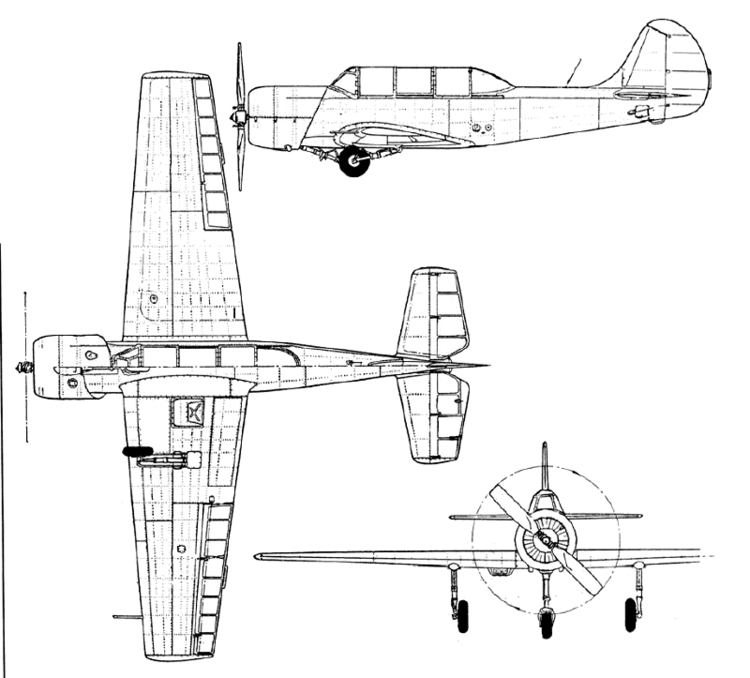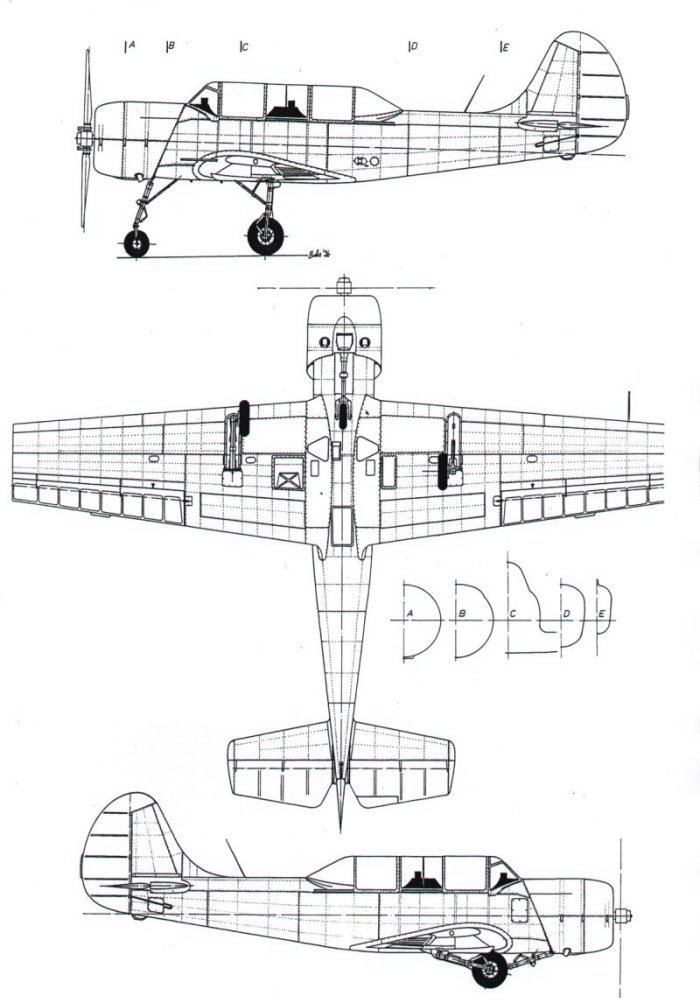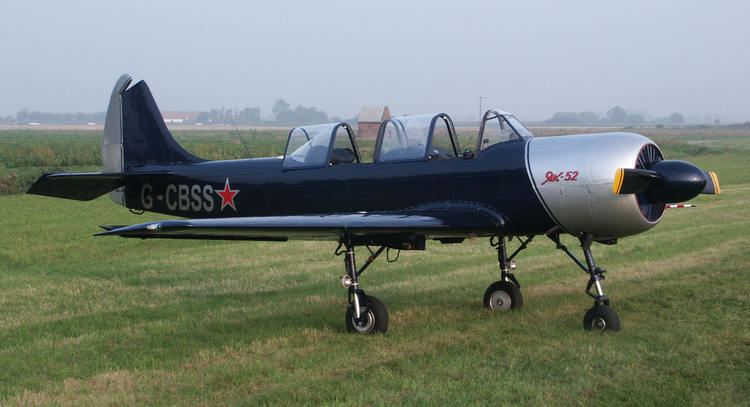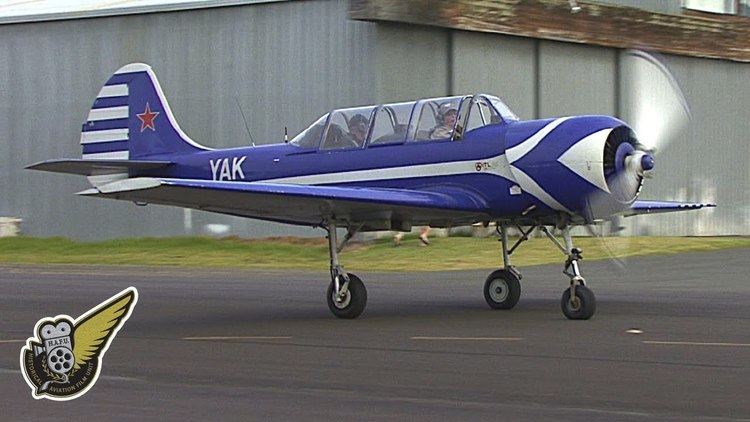Top speed 285 km/h Wingspan 9.3 m Weight 1,015 kg | Range 550 km Length 7.48 m | |
 | ||
Dutchrc crash of the avios yakovlev yak 52 1200mm
The Yakovlev Yak-52 (Russian: Яковлев Як-52) is a Soviet primary trainer aircraft which first flew in 1976. It is still being produced in Romania by Aerostar, as Iak-52, which gained manufacturing rights under agreement within the now defunct COMECON socialist trade organisation. The Yak-52 was designed originally as an aerobatic trainer for students in the Soviet DOSAAF training organisation, which trained both civilian sport pilots and military pilots.
Contents
- Dutchrc crash of the avios yakovlev yak 52 1200mm
- Design and development
- Variants
- Military operators
- Specifications Yak 52
- World Championships
- References

Since the early 1990s and the fall of the Soviet Union, many Yak 52s have been exported to the west. Of the approximately 2150 produced to date, most now fly in the United States, United Kingdom, New Zealand, Australia and other western countries.

Design and development

A descendant of the single-seat competition aerobatic Yakovlev Yak-50, the all-metal Yak-52 is powered by a 268 kW (360 hp) Vedeneyev M14P nine-cylinder radial engine.

Since the aircraft was designed to serve as a military trainer, the development of the aircraft incorporates a number of features to be found on the early postwar fighters: notably the cockpit tandem layout (instrument panel, seat design, cockpit opening system), tail design, tricycle landing gear, fuselage mixed construction (monocoque with steel tube construction), inner flaps, controls position, access panels on sides of the fuselage, even the location of the radio antena and overall dimensions of the airplane, which extensively match the Yakovlev Yak-17 UTI jet fighter trainer (NATO code name Magnet).

It is obvious that the Yakovlev design bureau, at the time of the aircraft's conception, had in mind a more economical and easier-to-maintain "Yak-17 UTI piston-engine version" for the military.
The aircraft has inverted fuel and oil systems permitting inverted flight for as long as two minutes. The engine drives a two-bladed counter-clockwise rotating, variable pitch, wood and fiberglass laminate propeller.
At 998 kg (2,200 lb) empty weight, the Yak-52 is responsive and very capable as an aerobatic aircraft. Yet it is also easy to fly and land. It has been used in international aerobatic competition up to the Advanced level. It is stressed to +7 and –5 Gs, rolls (to the right) at 180 degrees/second and is capable of every manoeuvre in the Aresti catalog.
The Yak-52, like most Soviet military aircraft, was designed to operate in rugged environments with minimal maintenance. One of its key features, unusual in western aircraft, is its extensive pneumatic system. Engine starting, landing gear, flaps, and wheel brakes are all pneumatically actuated. Spherical storage bottles for air, replenished by an engine driven compressor, are situated behind the rear cockpit and contents displayed on the instrument panels. The operating pressure is between 10 and 50 bars (145 and 725 psi) and an emergency circuit is reserved for lowering the undercarriage if the normal supply is exhausted or the compressor fails. Additionally both main and reserve bottles can be charged from a port on the ground with compressed air, usually from a Scuba type air bottle. The ground steering/braking arrangement, especially, takes some adjustment for flyers accustomed to hydraulics, because the aircraft uses differential braking controlled by rudder pedals and a hand operated lever on the control stick.
The tricycle landing gear is retractable, but it remains partially exposed in the retracted position, affording both a useful level of drag in down manoeuvres and a measure of protection should the aircraft be forced to land "wheels up."
A number of "westernised" versions of the Yak-52 are now produced. The replacement of the existing Soviet avionics, fitting of a three-blade propeller and the M14PF 298 kW (400 hp) upgrade to the usual 360 hp M14P engine, and conversion to conventional "tail-dragger" landing gear (Yak-52TD) are some of the modifications made to the standard aircraft. There is also a factory-produced Yak-52TW tail-dragger version. The TW has an extra 120 l (32 US gal) of fuel capacity in two extra wing tanks, the M14PF engine designated & three blade propeller, an electric start, and modern instruments.
On April 16, 2004, a modernised variant Yak-52M was flown in Russia. It is fitted with modernised M-14Kh engine, three-blade propeller, and other modifications.
Variants
Military operators
Specifications (Yak 52)
Data from Jane's All The World's Aircraft 1993-94
General characteristics
Performance
World Championships
Since 2008, Fédération Aéronautique Internationale organized official YAK-52 Aerobatics championships.
